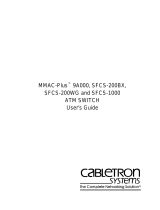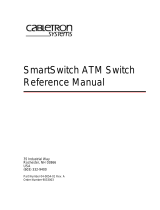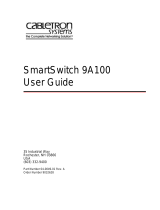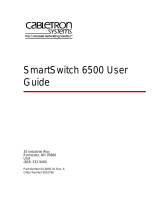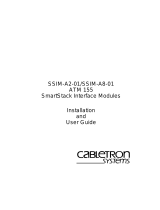Page is loading ...

ATM Switch
Configuration Manual


i
Notice
Notice
Cabletron Systems reserves the right to make changes in specifications and other information
contained in this document without prior notice. The reader should in all cases consult Cabletron
Systems to determine whether any such changes have been made.
The hardware, firmware, or software described in this manual is subject to change without notice.
IN NO EVENT SHALL CABLETRON SYSTEMS BE LIABLE FOR ANY INCIDENTAL, INDIRECT,
SPECIAL, OR CONSEQUENTIAL DAMAGES WHATSOEVER (INCLUDING BUT NOT LIMITED
TO LOST PROFITS) ARISING OUT OF OR RELATED TO THIS MANUAL OR THE INFORMATION
CONTAINED IN IT, EVEN IF CABLETRON SYSTEMS HAS BEEN ADVISED OF, KNOWN, OR
SHOULD HAVE KNOWN, THE POSSIBILITY OF SUCH DAMAGES.
© Copyright April 1996 by:
Cabletron Systems, Inc.
35 Industrial Way
Rochester, NH 03867-5005
All Rights Reserved
Printed in the United States of America
Order Number: 9031917
SPECTRUM
,
Remote LANVIEW
,
and
LANVIEW
are registered trademarks and
MMAC-Plus
is
a
trademark of Cabletron Systems, Inc.
Ethernet
is a trademark of Xerox Corporation.

Notice
ii
FCC Notice
This device complies with Part 15 of the FCC rules. Operation is subject to the following two
conditions: (1) this device may not cause harmful interference, and (2) this device must accept any
interference received, including interference that may cause undesired operation.
NOTE:
This equipment has been tested and found to comply with the limits for a Class A digital
device, pursuant to Part 15 of the FCC rules. These limits are designed to provide reasonable
protection against harmful interference when the equipment is operated in a commercial environment.
This equipment uses, generates, and can radiate radio frequency energy and if not installed in
accordance with the operator’s manual, may cause harmful interference to radio communications.
Operation of this equipment in a residential area is likely to cause interference in which case the user
will be required to correct the interference at his own expense.
WARNING:
Changes or modifications made to this device which are not expressly approved by the
party responsible for compliance could void the user’s authority to operate the equipment.
VCCI Notice
This equipment is in the 1st Class Category (information equipment to be used in commercial and/or
industrial areas) and conforms to the standards set by the Voluntary Control Council for Interference
by Information Technology Equipment (VCCI) aimed at preventing radio interference in commercial
and/or industrial areas.
Consequently, when used in a residential area or in an adjacent area thereto, radio interference may be
caused to radios and TV receivers, etc.
Read the instructions for correct handling.

iii
Notice
DOC Notice
This digital apparatus does not exceed the Class A limits for radio noise emissions from digital
apparatus set out in the Radio Interference Regulations of the Canadian Department of
Communications.
Le présent appareil numérique n’émet pas de bruits radioélectriques dépassant les limites applicables
aux appareils numériques de la class A prescrites dans le Règlement sur le brouillage radioélectrique
édicté par le ministère des Communications du Canada.

Notice
iv

v
Table of Contents
Preface
Chapter Summaries ..................................................................................................xiii
Technical Support...................................................................................................... xiv
Typographical Styles.................................................................................................. xv
Important Information Indicators ...........................................................................xv
Laser Warning...........................................................................................................xvii
Safety Agency Compliance....................................................................................xviii
Safety Precautions............................................................................................xviii
Symbols .............................................................................................................xviii
Modifications to Equipment............................................................................. xix
Placement of a FORE Systems Product .......................................................... xix
Power Cord Connection.................................................................................... xix
Chapter 1 Configuring PVCs
1.2 Virtual Paths ......................................................................................................... 1-3
1.2.1 Through Paths............................................................................................ 1-4
1.2.2 Originating and Terminating Paths......................................................... 1-6
1.3 Listing Virtual Paths............................................................................................ 1-7
1.4 Virtual Channels................................................................................................. 1-10
1.4.1 Listing Virtual Channels......................................................................... 1-13
1.5 Creating Permanent Virtual Circuits (PVCs) ................................................. 1-15
1.5.1 Creating a Virtual Path............................................................................ 1-15
1.5.1.1 Terminating a PVC at a Switch.................................................... 1-18
1.5.1.2 Creating ATM ARP Entries........................................................... 1-19
1.5.1.3 Listing ATM ARP Entries ............................................................. 1-20
1.5.2 Creating a Virtual Channel..................................................................... 1-21
1.6 Traffic Types........................................................................................................ 1-23
1.7 Traffic Policing (Usage Parameter Control).................................................... 1-24
1.7.1 Setting the CLP Bit................................................................................... 1-24
1.7.2 Leaky Bucket Algorithm......................................................................... 1-24
1.7.3 UNI 3.0 UPC Traffic Contract Parameters............................................ 1-25
1.7.4 AMI UPC Commands ............................................................................. 1-27
Chapter 2 Configuring a Classical IP ATM Network
2.1.1 Logical IP Subnets...................................................................................... 2-2
2.1.2 Classical IP Interfaces................................................................................2-2
2.1.3 SPANS Interface ......................................................................................... 2-3
2.2 Address Registration and ILMI ......................................................................... 2-4
2.2.1 NSAP Addresses ........................................................................................ 2-4
2.2.2 Operating with ILMI Support.................................................................. 2-5
2.2.3 Operating without ILMI Support............................................................ 2-5
2.2.4 Configuration ............................................................................................. 2-5
2.3 ARP and ARP Servers.......................................................................................... 2-6

Contents
vi
2.3.1 Theory..........................................................................................................2-6
2.3.2 Configuring a Host to be an ARP Server................................................2-7
2.3.2.1 Configuring a Host as an ARP Server for One-Time Use ..........2-8
2.3.2.2 Configuring a Host as a Permanent ARP Server.........................2-9
2.3.2.3 Configuring a Hewlett-Packard Computer as an ARP Server 2-10
2.3.3 Configuring a Cabletron Switch to be an ARP Server........................ 2-11
2.3.4 Classical IP Operation .............................................................................2-12
2.3.5 Operational Issues....................................................................................2-13
2.4 Classical IP PVCs................................................................................................2-14
2.4.1 Theory and Configuration......................................................................2-14
2.4.2 Revalidation and Removal .....................................................................2-15
2.5 Debugging...........................................................................................................2-16
2.6 Configuring the Network..................................................................................2-17
2.6.1 Third-Party Host with No ILMI and No RFC-1577 Support.............2-18
2.6.2 Third-Party Switch with ILMI and No RFC-1577 Support................2-19
2.6.3 Third-Party Switch with RFC-1577 and No ILMI Support................2-20
Chapter 3 Configuring an Emulated LAN
3.1 Introduction ..........................................................................................................3-1
3.2 Emulated LAN Components..............................................................................3-2
3.2.1 LAN Emulation Client (LEC)...................................................................3-3
3.2.2 LAN Emulation Configuration Server (LECS) ......................................3-3
3.2.3 LAN Emulation Server (LES)...................................................................3-3
3.2.4 Broadcast and Unknown Server (BUS)...................................................3-3
3.3 Emulated LAN Operation...................................................................................3-4
3.3.1 Initialization................................................................................................3-6
3.3.2 Registration and Address Resolution......................................................3-6
3.3.3 Data Transfer...............................................................................................3-7
3.4 Configuring an ELAN .........................................................................................3-8
3.4.1 Configuring an LECS Configuration Database File..............................3-9
3.4.1.1 Before You Begin ..............................................................................3-9
3.4.1.2 LECS Configuration File Syntax..................................................3-10
3.4.1.3 Defining an ELAN .........................................................................3-12
3.4.1.4 Defining a Client ............................................................................3-14
3.4.1.5 LECS Control Parameters.............................................................3-15
3.4.2 Sample LECS Configuration File ...........................................................3-16
3.4.3 The Default LECS Configuration File ...................................................3-19
3.4.4 Starting the LAN Emulation Services ...................................................3-21
3.4.4.1 Starting the LECS...........................................................................3-21
3.4.4.2 Creating a LES and a BUS.............................................................3-23
3.4.5 Starting the LEC(s) and Joining an ELAN............................................3-24
3.4.5.1 Creating a LEC ...............................................................................3-24
3.4.5.2 Configuring the LEC Failover Mechanism ................................3-26

vii
Contents
Chapter 4 SONET Configuration
4.1.1 Transmit Indicators.................................................................................... 4-1
4.1.2 Receive Indicators......................................................................................4-2
4.2 Configuring SONET Mode................................................................................. 4-2
4.3 Configuring SONET Empty Cells...................................................................... 4-3
4.4 Configuring SONET Loopback.......................................................................... 4-4
4.4.1 Diagnostic Loopback................................................................................. 4-4
4.4.2 Line Loopback............................................................................................ 4-4
4.5 Displaying SONET Error Counters................................................................... 4-6
4.6 SONET Error Counter Descriptions.................................................................. 4-7
4.7 Configuring SONET Timing............................................................................. 4-10
Chapter 5 DS-3 Configuration
5.1.1 Transmit Indicators.................................................................................... 5-1
5.1.2 Receive Indicators......................................................................................5-1
5.2 Configuring DS-3 Mode...................................................................................... 5-2
5.3 Configuring DS-3 Empty Cells........................................................................... 5-3
5.4 Configuring DS-3 Line Length........................................................................... 5-3
5.5 Configuring DS-3 Framing ................................................................................. 5-4
5.6 Configuring DS-3 Payload Scrambling............................................................. 5-5
5.7 Configuring DS-3 Loopback...............................................................................5-6
5.7.1 Cell Loopback............................................................................................. 5-7
5.7.2 Payload Loopback ..................................................................................... 5-7
5.7.3 Diagnostic Loopback................................................................................. 5-7
5.7.4 Line Loopback............................................................................................ 5-7
5.8 Displaying DS-3 Error Counters........................................................................ 5-8
5.9 DS-3 Error Counter Descriptions....................................................................... 5-9
5.10 Configuring DS-3 Timing................................................................................ 5-11
Chapter 6 E-3 Configuration
6.1.1 Transmit Indicators.................................................................................... 6-1
6.1.2 Receive Indicators......................................................................................6-1
6.2 Configuring E-3 Mode......................................................................................... 6-2
6.3 Configuring E-3 Payload Scrambling................................................................ 6-2
6.4 Configuring E-3 Loopback.................................................................................. 6-3
6.4.1 Cell Loopback............................................................................................. 6-4
6.4.2 Payload Loopback ..................................................................................... 6-4
6.4.3 Diagnostic Loopback................................................................................. 6-4
6.4.4 Line Loopback............................................................................................ 6-4
6.5 Configuring E-3 Empty Cells ............................................................................. 6-5
6.6 Displaying E-3 Error Counters........................................................................... 6-6
6.7 E-3 Error Counter Descriptions.......................................................................... 6-7
6.8 Configuring E-3 Timing ...................................................................................... 6-9

Contents
viii
Chapter 7 TP25 Configuration
8.1.1 Transmit Indicators....................................................................................7-1
8.1.2 Receive Indicators......................................................................................7-1
8.2 Configuring TP25 Loopback...............................................................................7-2
8.2.1 Line Loopback ............................................................................................7-2
8.3 Displaying TP25 Error Counters........................................................................7-4
8.4 TP25 Error Counter Descriptions.......................................................................7-4
Chapter 8 TAXI Configuration
9.1.1 Transmit Indicators....................................................................................8-1
9.1.2 Receive Indicators......................................................................................8-1
9.2 Configuring TAXI Loopback ..............................................................................8-2
Appendix A AMI Overview
A.1.1 Login from Serial Port.............................................................................A-3
A.1.2 Login from Telnet.....................................................................................A-4
A.2 AMI Commands Not Available When Running Remotely.........................A-6
A.3 AMI Root Menu for an Open Session .............................................................A-7
A.3.1 About Command .....................................................................................A-8
A.3.2 Close Command.......................................................................................A-9
A.3.3 Configuration Commands....................................................................A-10
A.3.4 Exit Command........................................................................................A-10
A.3.5 Help Command......................................................................................A-10
A.3.6 History Command.................................................................................A-11
A.3.7 Open Command.....................................................................................A-12
A.3.8 Operation Commands...........................................................................A-13
A.3.9 Ping Command ......................................................................................A-13
A.3.10 Redo Command ...................................................................................A-14
A.3.11 Rows Command...................................................................................A-16
A.3.12 Statistics Commands ...........................................................................A-16
A.3.13 Top Command......................................................................................A-16
A.3.14 Up Command.......................................................................................A-16
Appendix B AMI Configuration Commands
B.1.1 Displaying Alarm Conditions..................................................................B-2
B.1.2 Enabling an Alarm.....................................................................................B-3
B.1.3 Disabling an Alarm ...................................................................................B-4
B.1.4 Resetting an Alarm....................................................................................B-5
B.2 ATM ARP Configuration Commands...............................................................B-6
B.2.1 ARP Server Configuration Commands..................................................B-6
B.2.2 Deleting an ARP Entry..............................................................................B-7
B.2.3 Flushing the ATM ARP Cache .................................................................B-8
B.2.4 Getting the NSAP Address for a Classical IP Interface........................B-8

ix
Contents
B.2.5 Creating an IP to NSAP Address Mapping ...........................................B-8
B.2.6 Creating a Classical IP PVC .....................................................................B-9
B.2.7 Creating a FORE IP PVC ARP Entry .....................................................B-9
B.2.8 Displaying the ATM ARP Entries..........................................................B-10
B.3 Switch Board Configuration Commands.......................................................B-11
B.3.1 Configuring the Clock Scaling Factor on a Switch Board..................B-11
B.3.2 Displaying the Board Configuration ....................................................B-12
B.3.3 Displaying the Board Topology.............................................................B-13
B.4 IP Configuration Commands...........................................................................B-14
B.4.1 Configuring the IP Address ...................................................................B-14
B.4.2 Configuring the IP State .........................................................................B-15
B.4.3 Configuring the IP Broadcast Address.................................................B-15
B.4.4 Configuring IP Forwarding ...................................................................B-16
B.4.5 Configuring the IP Subnet Mask...........................................................B-16
B.4.6 Configuring IP Routes ............................................................................B-17
B.4.7 Displaying the IP Interface Configuration...........................................B-19
B.5 LAN Emulation Configuration Commands ..................................................B-20
B.5.1 Broadcast and Unknown Server (BUS) Configuration Commands.B-20
B.5.2 LAN Emulation Client (LEC) Configuration Commands.................B-24
B.5.3 LAN Emulation Configuration Server (LECS) Commands ..............B-31
B.5.4 LAN Emulation Server (LES) Configuration Commands.................B-36
B.6 Network Module Configuration Commands................................................B-42
B.6.1 Displaying Network Module Configuration Information ................B-42
B.6.2 Configuring Distributed Timing on a Network Module...................B-43
B.6.3 Configuring Traffic on a Network Module..........................................B-48
B.7 NSAP Configuration Commands....................................................................B-53
B.7.1 NSAP Route Configuration Commands..............................................B-53
B.7.2 NSAP Prefix Configuration Commands ..............................................B-56
B.7.3 NSAP ILMI Configuration Command .................................................B-59
B.8 Port Configuration Commands.......................................................................B-60
B.8.1 CDVT Port Configuration Commands.................................................B-60
B.8.2 E-3 Port Configuration Commands......................................................B-61
B.8.3 TP25 Port Configuration Commands...................................................B-66
B.8.4 DS-3 Port Configuration Commands ...................................................B-68
B.8.5 J-2 Port Configuration Commands .......................................................B-73
B.8.6 Port Policing Configuration Command ...............................................B-76
B.8.7 SONET Port Configuration Commands ..............................................B-77
B.8.8 Showing the Port Configuration ...........................................................B-82
B.8.9 TAXI Port Configuration Commands...................................................B-85
B.8.10 Traffic Port Configuration Commands...............................................B-87
B.8.11 VBROB Port Configuration Commands.............................................B-93
B.8.12 VBRBuffOB Port Configuration Commands.....................................B-93
B.9 Serial Port Configuration Commands ............................................................B-94
B.9.1 Displaying Serial Port Information.......................................................B-94
B.10 SNMP Configuration Commands.................................................................B-95
B.10.1 Configuring the SNMP Community Access......................................B-95
B.10.2 Configuring SNMP Traps.....................................................................B-95
B.11 SPANS Configuration Commands ................................................................B-98
B.11.1 Deleting a SPANS Signalling Path ......................................................B-98
B.11.2 Creating a SPANS Signalling Path ......................................................B-99

Contents
x
B.11.3 Showing the SPANS Signalling Path Configuration.......................B-101
B.12 SPVC Configuration Commands.................................................................B-104
B.12.1 Deleting an SPVC ................................................................................B-104
B.12.2 Creating an SPVC ................................................................................B-105
B.12.3 Displaying SPVC Information...........................................................B-107
B.13 Switch Configuration Commands...............................................................B-108
B.13.1 Setting or Changing the Switch Name .............................................B-108
B.13.2 Setting the Minimum Number of Reserved VCIs for PMPs .........B-109
B.13.3 Setting the Maximum Number of Reserved VCIs for PMPs.........B-110
B.13.4 Displaying the Switch Configuration...............................................B-111
B.14 System Configuration Commands..............................................................B-112
B.14.1 Displaying System Information.........................................................B-112
B.14.2 System Log Configuration Commands............................................B-113
B.14.3 AMI Timeout Configuration Command ..........................................B-117
B.14.4 Configuring the Units for UPC Contracts........................................B-117
B.15 Topology Configuration Commands ..........................................................B-118
B.15.1 ForeThought PNNI Configuration Commands..............................B-118
B.15.2 SPANS Topology Configuration Commands ..................................B-126
B.16 UNI 3.0 Configuration Commands.............................................................B-128
B.16.1 Deleting a UNI 3.0 Signalling Path ...................................................B-128
B.16.2 Creating a UNI 3.0 Signalling Path...................................................B-129
B.16.3 Displaying UNI 3.0 Signalling Paths ................................................B-131
B.17 Usage Parameter Control Configuration Commands..............................B-134
B.17.1 Deleting a UPC Traffic Contract........................................................B-134
B.17.2 Creating a UPC Traffic Contract........................................................B-135
B.17.3 Displaying the UPC Traffic Contracts...............................................B-137
B.18 Virtual Channel Configuration Commands...............................................B-138
B.18.1 Deleting a Virtual Channel.................................................................B-138
B.18.2 Modifying a Virtual Channel.............................................................B-139
B.18.3 Creating a Virtual Channel.................................................................B-139
B.18.4 Displaying the Virtual Channel Configuration...............................B-141
B.19 Virtual Path Configuration Commands .....................................................B-143
B.19.1 Deleting a Virtual Path........................................................................B-143
B.19.2 Modifying a Virtual Path....................................................................B-144
B.19.3 Creating a Virtual Path .......................................................................B-145
B.19.4 Displaying Virtual Paths.....................................................................B-149
Appendix C AMI Operation Commands
C.1.1 Backing Up the Database ........................................................................ C-2
C.1.2 Initializing the Database.......................................................................... C-3
C.1.3 Resetting the Database ............................................................................ C-4
C.1.4 Restoring the Database............................................................................ C-4
C.2 Environment Commands.................................................................................. C-5
C.2.1 CPU Operation ......................................................................................... C-5
C.2.2 Switch Fabric Operation.......................................................................... C-6
C.2.3 Showing Switch Fabric Temperature Information .............................. C-6
C.2.4 Configuring the Switch Fabric Temperature Thresholds ................... C-7
C.2.5 Fan Operation........................................................................................... C-8

xi
Contents
C.2.6 Power Supply Operation ........................................................................ C-9
C.2.7 Temperature Sensor Operation............................................................ C-10
C.2.8 Panic Acknowledgment Commands...................................................C-11
C.2.9 Clearing the Panic Flag ..........................................................................C-11
C.2.10 Displaying the Panic Dump File........................................................ C-12
C.3 Displaying and Setting the Date and Time................................................... C-14
C.4 FLASH Operation Commands....................................................................... C-15
C.4.1 Copying a File to FLASH Memory...................................................... C-15
C.4.2 Deleting a File from FLASH Memory................................................. C-16
C.4.3 Displaying the FLASH Memory Directory ........................................ C-17
C.4.4 Displaying Free Space on the FLASH File.......................................... C-17
C.4.5 Getting a FLASH File............................................................................. C-17
C.4.6 Initializing the FLASH File................................................................... C-18
C.4.7 Putting a FLASH File on a Remote Host ............................................ C-18
C.4.8 Renaming a FLASH File........................................................................ C-19
C.5 Setting or Changing the Password ................................................................ C-19
C.6 Upgrading the Switch...................................................................................... C-20
C.7 Displaying and Changing the Version of Software..................................... C-21
C.8 Rebooting the Switch....................................................................................... C-21
Appendix D AMI Statistics Commands
D.2 AAL4 Statistics ...................................................................................................D-2
D.3 AAL5 Statistics ...................................................................................................D-3
D.4 ATM Statistics.....................................................................................................D-4
D.5 Switch Board Statistics ...................................................................................... D-5
D.6 Control Port Statistics........................................................................................D-5
D.7 DS-3 Statistics .....................................................................................................D-6
D.8 E-3 Statistics ........................................................................................................D-9
D.9 ICMP Statistics..................................................................................................D-12
D.10 Interface Statistics ..........................................................................................D-15
D.11 IP Statistics ......................................................................................................D-17
D.12 Network Module Statistics ...........................................................................D-20
D.13 Port Statistics ..................................................................................................D-22
D.14 SONET Statistics ............................................................................................D-23
D.15 SPANS Statistics .............................................................................................D-26
D.16 TCP Statistics .................................................................................................. D-27
D.17 TP25 Statistics................................................................................................. D-29
D.18 UDP Statistics ................................................................................................. D-30
D.19 UNI 3.0 Statistics ............................................................................................D-31
D.20 VCC Statistics .................................................................................................D-32
D.21 VPC Statistics.................................................................................................. D-33

Contents
xii
Appendix E SNMP Configuration
E.2 SNMP Traps..........................................................................................................E-3
E.2.1 Adding SNMP Trap Destinations..........................................................E-11
E.2.2 Displaying SNMP Trap Destinations....................................................E-11
E.2.3 Removing SNMP Trap Destinations.....................................................E-12
Appendix F ForeThought PNNI
F.1.1 Hello Protocol .............................................................................................F-2
F.1.2 Topology Database Exchange...................................................................F-2
F.1.3 Flooding.......................................................................................................F-2
F.1.4 Hierarchical Routing..................................................................................F-3
F.2 The Physical Network..........................................................................................F-5
F.2.1 Peer Groups.................................................................................................F-8
F.2.2 Peer Group Topology.................................................................................F-8
F.2.3 Border Switches..........................................................................................F-8
F.2.4 Peer Group Summary Node (PGSN) ......................................................F-9
F.2.5 Backbone Topology....................................................................................F-9
F.2.6 Single Switch Perspective .........................................................................F-9

xiii
PREFACE
This manual provides the technical information needed to configure the
ATM
Switches, the
LAN and WAN
network modules, and the accompanying
software. This document also provides general ATM information and general
product information. This document was created for users with various levels
of experience. If you have any questions or problems, please contact
Cabletron Systems’ Technical Support.
Chapter Summaries
Chapter 1 - Configuring
PVCs
- Describes how to create PVCs on a switch
through the ATM Management Interface (AMI).
Chapter 2 - Configuring a Classical IP ATM Network
- Describes how to
design, configure, and maintain a Classical IP ATM network.
Chapter 3 - Configuring an Emulated LAN
- Provides an overview of LAN
Emulation and gives an example of how to configure an Emulated LAN.
Chapter 4 - SONET Configuration
- Contains configuration information for
supporting SONET network modules.
Chapter 5 - DS-3 and DS-1 Configuration
- Contains configuration informa-
tion for supporting DS-3 and DS-1 network modules.
Chapter 6 - E-3 and E-1 Configuration
- Contains configuration information
for supporting E-3 and E-1 network modules.
Chapter 7 - J-2 Configuration
- Contains configuration information for sup-
porting J-2 network modules.
Chapter 8 - TP25 Configuration
- Contains configuration information for sup-
porting TP25 network modules.
Chapter 9 - TAXI Configuration
-
Contains configuration information for
supporting TAXI network modules.
Appendix A - AMI Overview
- Provides an overview of AMI and contains a
text and graphical description of the root level AMI commands.

xiv
PREFACE
Appendix B - AMI Configuration Commands
- Contains a text and graphical
description of the configuration level AMI commands.
Appendix C - AMI Operation Commands
- Contains a text and graphical
description of the operation level AMI commands.
Appendix D - AMI Statistics Commands
- Contains a text and graphical
description of the statistics level AMI commands.
Appendix E - SNMP
Configuration
- Describes the remote SNMP configura-
tion of a switch.
Appendix F -
PNNI
- Describes how this scalable routing and signalling pro-
tocol can be used to simplify large network topologies.
Technical Support
If you need additional support with these products, or if you have any
questions, comments or suggestions concerning this manual, feel free to
contact Cabletron Systems Technical Support:
By phone: (603) 332-9400
By CompuServe: GO CTRON from any ! prompt
By Internet mail: [email protected]
By mail: Cabletron Systems, Inc.
P.O. Box 5005
Rochester, NH 03867-0505

xv
PREFACE
Typographical Styles
Throughout this manual, all specific commands meant to be entered by the
user will appear on a separate line in bold typeface. In addition, use of the
Enter
or
Return
key will be represented as
<ENTER>
. The following example
demonstrates this convention.
cd /usr <ENTER>
Commands or file names that appear within the text of this manual will be
represented in the following style: “...the
fore_install
program will install this
distribution”.
As in the following example, any messages that appear on your screen during
software installation and network interface administration will appear in
Courier
font to distinguish them from the rest of the text.
....
Are all four conditions true?
Important Information Indicators
To call your attention to safety and otherwise important information that
must be reviewed to ensure correct and complete installation, as well as to
avoid damage to the ATM Switch or your system, this manual utilizes the fol-
lowing
WARNING/CAUTION/NOTE
indicators.
WARNING
statements contain information that is critical to the safety of the
operator and/or the system. Do not proceed beyond a
WARNING
statement
until the indicated conditions are fully understood or met. This information
could prevent serious injury to the operator, damage to the Switch, the sys-
tem, or currently loaded software, and will be indicated as follows:
WARNING!
Hazardous voltages are present. To reduce the
risk of electrical shock and danger to personal
health, follow the instructions carefully.
Information contained in
CAUTION
statements is important for proper

xvi
PREFACE
installation/operation.
CAUTION
statements can prevent possible equip-
ment damage and/or loss of data and will be indicated as:
CAUTION
You risk damaging your equipment and/or
software if you do not follow these
instructions.
Information contained in
NOTE
statements has been found important
enough to be called to the special attention of the operator and will be set off
from the text as follows:
NOTE:
It is strongly recommended that you discon-
nect the serial cable once you have configured
the ATM switch and then access the switch
over the ATM network.

xvii
PREFACE
Laser Warning
Class 1 lasers are defined as products which do not permit human access to
laser radiation in excess of the accessible limits of Class 1 for applicable wave-
lengths and durations. These lasers are safe under reasonably foreseeable
conditions of operation.
The following network modules contain Class 1 lasers:
NM-2/155SMSRA-1 NM-2/155SMSRB-1 NM-2OC3/SMSRA-1
NM-4/155SMSRA-1 NM-4/155SMSRB-1 NM-4OC3/SMSRA-1
NM-4OC3/SMSRA-1A NM-4OC3/SMSRB-1 NM-2/155SMSRC
NM-4/155SMSRC NM-2/155SMLRA-1 NM-2/155SMLRB-1
NM-2/155SMLRC-1 NM-2OC3/SMLRB-1 NM-2OC3/SMMRA-1
NM-4/155SMLRB-1 NM-4/155SMLRC-1 NM-4OC3/SMLRB-1
NM-4OC3/SMMRA-1 NM-1/622SMIRC NM-4/155LR3SCC
NM-4/155SR3SCC
Class 1 Laser Product:
This product conforms to
applicable requirements of
21 CFR 1040 at the date of
manufacture.

xviii
PREFACE
Safety Agency Compliance
This preface provides safety precautions to follow when installing a product.
Safety Precautions
For your protection, observe the following safety precautions when setting up
your equipment:
• Follow all warnings and instructions marked on the equipment.
• Ensure that the voltage and frequency of your power source matches
the voltage and frequency inscribed on the equipment’s electrical rat-
ing label.
• Never push objects of any kind through openings in the equipment.
Dangerous voltages may be present. Conductive foreign objects
could produce a short circuit that could cause fire, electric shock, or
damage to your equipment.
Symbols
The following symbols appear in this book.
CAUTION
If instructions are not followed, there is a risk
of damage to the equipment.
WARNING!
Hazardous voltages are present. If the instruc-
tions are not heeded, there is a risk of electrical
shock and danger to personal health.
/
